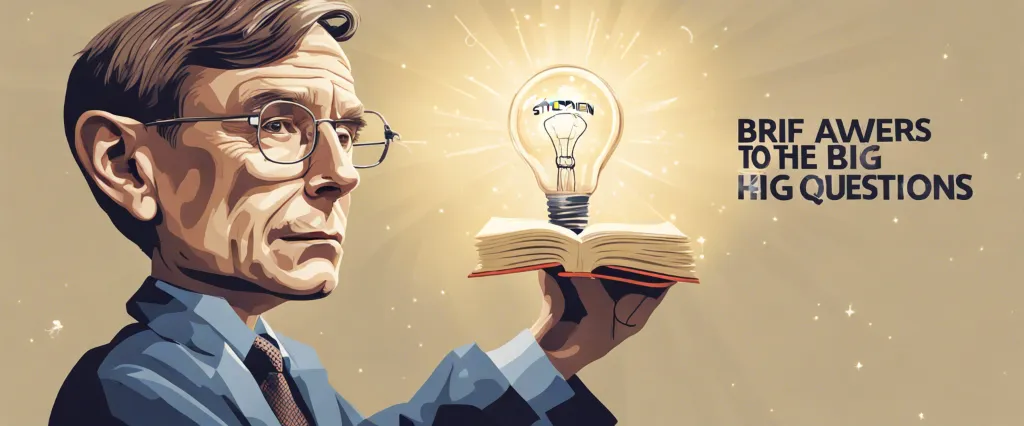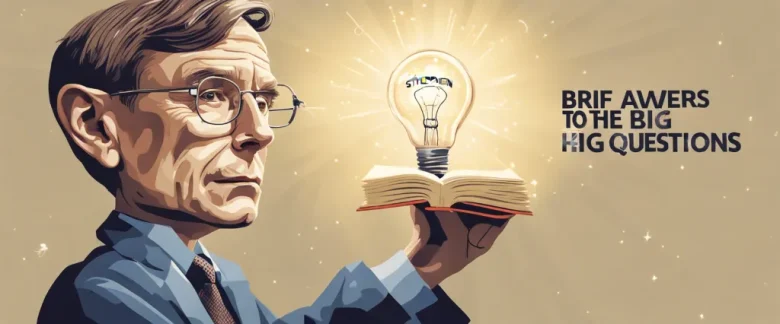
In the captivating book, “Brief Answers to the Big Questions,” renowned physicist Stephen Hawking dives deep into the fundamental questions that have puzzled humanity for centuries. With his characteristic brilliance and insight, Hawking tackles complex topics such as the existence of God, the origins of the universe, and the future of humanity. As one of the most influential scientists of our time, Hawking’s work revolutionized our understanding of black holes and the laws of physics. Despite his physical limitations due to ALS, he continued to explore the mysteries of the cosmos until his passing in 2018. This posthumous publication serves as a culmination of his lifelong pursuit of knowledge and serves as a testament to his profound contributions to science and humanity.
Chapter 1: Is there a God?
Chapter 1 of “Brief Answers to the Big Questions” by Stephen Hawking explores the age-old question of whether or not there is a God. Hawking begins by acknowledging that throughout human history, people have sought to understand the origins and purpose of the universe, often attributing these mysteries to a higher power. He points out that the concept of a God has provided solace and comfort to many, giving meaning to their lives.
However, Hawking proceeds to present a scientific perspective on the existence of God. He highlights the role of the scientific method in helping humanity understand the workings of the universe. According to him, scientific theories and observations offer more reliable explanations for various phenomena, gradually replacing the need for religious explanations.
Hawking discusses key scientific discoveries, such as the Big Bang theory, which suggests that the universe began with an immense explosion about 13.8 billion years ago. He explains that as scientists study the universe’s origins, they are increasingly capable of proposing natural explanations for its existence, leaving less room for the need of a divine creator.
In closing, Hawking admits that while science has provided explanations for many mysteries, there is still much to discover and understand. He argues that the absence of evidence for God’s existence, combined with the ability of scientific theories to explain the universe’s origins, makes the existence of a creator less likely. However, he leaves room for readers to form their own opinions and encourages curiosity and open-mindedness in the quest for truth.
Chapter 2: How did it all begin?
In Chapter 2 of “Brief Answers to the Big Questions” by Stephen Hawking, titled “How did it all begin?”, the renowned physicist explores the origins of the universe. Hawking delves into different theories and scientific advancements that have shaped our understanding of the universe’s beginnings.
He starts by discussing the ancient beliefs and creation myths that attempted to explain how everything came into existence. These stories laid the foundation for early human understandings of creation but lacked systematic observations and scientific evidence.
Hawking then moves on to the contributions of pivotal scientists like Albert Einstein, Edwin Hubble, and Georges Lemaître. He explains how Einstein’s theory of general relativity provided the understanding that space and time are interconnected, leading to the concept of an expanding universe. Hubble’s observations of distant galaxies and Lemaître’s mathematical theories further supported the idea of a universe in constant expansion.
The chapter also introduces the concept of the Big Bang theory. According to this theory, the universe originated from a singular point of extreme density and temperature, expanding rapidly into its current state. Hawking explains that the Big Bang theory is strongly supported by astronomical observations, such as the redshift of distant galaxies.
Hawking further discusses the cosmic microwave background radiation, which is viewed as the “afterglow” of the Big Bang, and the role it plays in providing evidence for this theory.
In this chapter, Hawking summarizes the journey of human understanding regarding the universe’s beginning, from ancient beliefs to modern scientific theories. His explanations shed light on the key discoveries and developments that have shaped our current understanding.
Chapter 3: Is there other intelligent life in the universe?
Chapter 3 of the book “Brief Answers to the Big Questions” by Stephen Hawking discusses the intriguing question of whether there is other intelligent life in the universe. Hawking starts by acknowledging the vastness of the cosmos, with billions of galaxies each containing billions of stars. Given this enormous expanse, he believes it is highly unlikely that Earth is the only planet to host life.
Hawking highlights the importance of water in supporting life as we know it, and suggests that the presence of liquid water on other planets or moons within our own solar system, such as Mars or Europa, increases the possibility of finding extraterrestrial life. He posits that microbial life could be relatively common, but the existence of more advanced and intelligent forms of life remains uncertain.
The author also examines the concept of intelligent life developing on other planets. He argues that it took billions of years for intelligent life to evolve on Earth, and therefore, finding another civilization at an equivalent stage of development could be unlikely. Additionally, he emphasizes the possible challenges of communication and travel between civilizations due to the vast distances and time involved.
Hawking advises that we should continue to explore other planets and moons in search of signs of life. He also points out the potential risks of encountering a highly advanced alien civilization, cautioning that such encounters could be detrimental for humanity.
In summary, Chapter 3 of “Brief Answers to the Big Questions” presents a thought-provoking analysis that suggests the existence of other intelligent life in the universe is plausible but remains uncertain. The chapter encourages ongoing scientific exploration while advising caution in our endeavors.
Chapter 4: Can we predict the future?

In Chapter 4 of “Brief Answers to the Big Questions,” Stephen Hawking explores the fascinating topic of predicting the future. He begins by acknowledging that while we cannot predict specific events with absolute certainty, it is possible to make informed predictions based on statistical probabilities.
Hawking discusses the concept of determinism, which suggests that if we had comprehensive knowledge of the present, we could accurately predict the future. However, he highlights the limitations of such determinism due to the inherent unpredictability of quantum mechanics and the unpredictability of human behavior.
The author also emphasizes the role of scientific progress in predicting the future. By studying patterns and trends in various fields, such as climate change or population growth, scientists can make educated predictions about the future outcomes of these phenomena. Hawking acknowledges that these predictions are not absolute and can be influenced by various factors, but they provide valuable insights nonetheless.
Hawking then covers the influence of technological advancements on predicting the future. While he acknowledges the potential benefits of artificial intelligence (AI) and machine learning, he also cautions against the risks associated with these developments. The rapid growth of AI could lead to unpredictable consequences, especially if machines surpass human intellect and control.
Overall, Hawking emphasizes the importance of having a proactive approach towards the future, using predictions as tools to inform decision-making and shape a better world. While acknowledging the limitations and uncertainties involved, he encourages the use of scientific knowledge and rational thinking to face the challenges and opportunities that lie ahead.
Chapter 5: What is inside a black hole?
Chapter 5 of “Brief Answers to the Big Questions” by Stephen Hawking delves into the mysteries surrounding the nature of black holes. Hawking begins by explaining that black holes are formed when a massive star collapses under its own gravitational pull, creating an extremely dense region with intense gravity that nothing can escape, not even light.
Hawking then discusses the concept of an event horizon, a boundary beyond which no information or light can escape from the black hole. He emphasizes that the event horizon is not a physical surface but is determined by the point of no return, beyond which gravity’s grip becomes irreversible.
Furthermore, Hawking explores the phenomenon of Hawking radiation, a theoretical prediction suggesting that black holes can emit particles and energy over time. This radiation arises due to quantum effects near the event horizon, ultimately causing the black hole to gradually lose mass and energy.
In this chapter, Hawking also addresses the question of what would happen if someone were to venture inside a black hole. According to him, once a person crosses the event horizon, they would be pulled in towards the singularity at the center of the black hole. As they get closer, gravity’s tidal forces would become so extreme that they would be stretched and torn apart in a process known as spaghettification, ultimately leading to their demise.
Overall, Chapter 5 provides a concise but fascinating explanation of the inner workings of black holes, shedding light on some of the most enigmatic objects in the universe.
Chapter 6: Is time travel possible?
Chapter 6: Is time travel possible? from the book Brief Answers to the Big Questions by Stephen Hawking explores the fascinating concept of traversing through time. Hawking begins by acknowledging that while time travel has captivated the imaginations of many, it remains a highly controversial and speculative topic.
Hawking first discusses the concept of time dilation, as predicted by Einstein’s theory of relativity. Time dilation states that time passes more slowly for objects in motion or under the influence of intense gravitational fields. This phenomenon has been accurately measured using atomic clocks aboard high-speed jets and satellites, proving that time dilation is a real and measurable effect.
The possibility of time travel into the future is explored, and Hawking believes this to be theoretically plausible. By traveling close to the speed of light or by entering an intense gravitational field, time dilation could occur, causing an individual to experience time passing slower than for those who remain stationary. As a result, someone traveling at significant speeds or near a massive object would arrive in the future, having aged much less than those who remained behind.
However, traveling back in time proves to be far more challenging. Hawking explains that to journey into the past, one would need to find a way to bend the fabric of spacetime, creating a traversable wormhole or utilizing exotic matter with negative energy density. While these concepts are theoretically possible, their practicality and implementation remain purely speculative.
Hawking concludes the chapter by acknowledging the vibrant debates and discussions surrounding time travel, highlighting the need for further research and technological advancements to truly determine its feasibility. Time travel, although an intriguing concept, remains firmly rooted in the realm of science fiction for the time being.
Chapter 7: Will we survive on Earth?
Chapter 7 of “Brief Answers to the Big Questions” by Stephen Hawking, titled “Will we survive on Earth?”, explores various threats that humanity faces and the potential future survival of our species on Earth.
Hawking begins by discussing the advancements in science and technology that have propelled our civilization forward but have also brought significant challenges. He highlights the colossal damage caused by nuclear weapons, climate change, and the rapid spread of deadly viruses.
He emphasizes the pressing issue of climate change and its potential to render our planet uninhabitable. Hawking explains that global warming, caused largely by human activities, is leading to rising sea levels, extreme weather events, and the destruction of ecosystems. If we don’t take immediate action to mitigate these effects, Hawking warns that the consequences could be catastrophic for humanity.
Hawking also addresses the possibility of an asteroid impact, noting that while the chances are relatively low, the impact could have devastating consequences and wipe out a significant portion of life on Earth. He suggests developing systems to detect and divert asteroids to avoid such a catastrophe.
Additionally, Hawking delves into the risks associated with advances in biotechnology and artificial intelligence. He raises concerns about the potential misuse of these technologies, emphasizing the importance of responsible regulation to prevent dire consequences.
Despite highlighting these threats, Hawking remains optimistic and acknowledges that humans are intelligent and resourceful enough to find solutions. He emphasizes the need for global cooperation and concerted efforts to tackle these challenges. Hawking believes that by harnessing our scientific knowledge and working together, humans can secure a sustainable future for ourselves on Earth.

Chapter 8: How can we shape the future?
Chapter 8 of “Brief Answers to the Big Questions” by Stephen Hawking explores the topic of how humankind can shape the future. In this chapter, Hawking delves into the possibilities and challenges associated with emerging technologies and the potential impacts they may have on our future as a species.
Hawking acknowledges that advancements in science and technology have the power to shape our destiny, but he also warns of the risks they present. One of the major concerns he raises is the development of artificial intelligence (AI). While AI offers great potential for solving complex problems and improving our lives, it also poses risks if not properly controlled. Hawking cautions against the creation of AI that surpasses human intelligence, as it could potentially outperform us in virtually every aspect, leading to unforeseen consequences.
Another area Hawking explores is genetic engineering. He highlights the benefits of modifying our genetic code to eradicate diseases and enhance physical and mental capabilities. However, he urges cautious and responsible use of this technology to avoid unintended consequences, such as creating a genetically divided society.
Hawking stresses the importance of international cooperation in addressing these technological challenges to ensure that everyone benefits from their positive impacts. He emphasizes that humans must work together to create laws and global institutions that regulate the use of these potentially transformative technologies.
In conclusion, Chapter 8 emphasizes the importance of striking a balance between the potential benefits and risks associated with emerging technologies. Hawking implores us to be proactive in shaping the future, ensuring that humanity remains in control of these powerful tools while taking steps to prevent their misuse. It is his hope that, with a collective effort, we can guide our future towards progress and avoid the pitfalls and dangers that lie ahead.
After Reading
In Brief Answers to the Big Questions, Stephen Hawking delves into some of the most profound questions about the universe and humanity. Through his signature blend of scientific knowledge, wit, and curiosity, Hawking provides insightful and thought-provoking answers to inquiries such as the existence of God, the nature of time, the possibility of extraterrestrial life, and the future of our planet. This book serves as a testament to Hawking’s exceptional intellect, resilience, and relentless pursuit of knowledge, leaving readers inspired to continue pondering these mysteries long after turning the final page. In his final work, Hawking encourages us to explore the universe with an open mind, fostering a sense of wonder and curiosity in our own quest for understanding.
1. Sapiens: A Brief History of Humankind” by Yuval Noah Harari – This book offers a fascinating exploration of humanity’s history, providing insights into our evolutionary journey and the impact we have had on the planet. Harari presents complex ideas in a highly accessible way, making it a thought-provoking and engaging read.
2. The Gene: An Intimate History” by Siddhartha Mukherjee – Drawing from his deep knowledge of genetics, Mukherjee provides a captivating narrative tracing the history and future of our understanding of genes. Exploring the ethical and scientific implications, this book offers a comprehensive and enlightening perspective on genetics.
3. The Immortal Life of Henrietta Lacks” by Rebecca Skloot – Skloot tells the remarkable true story of Henrietta Lacks, a woman whose cells were unknowingly taken for medical research and contributed significantly to countless scientific breakthroughs. Blending personal storytelling with scientific inquiry, this book delves into topics of ethics, consent, and the impact of medical advancements on individuals.
4. Thinking, Fast and Slow” by Daniel Kahneman – Kahneman, a Nobel laureate in economics, explores the dual systems of thinking that drive our decisions: the fast, intuitive system and the slower, more deliberate system. This book challenges our understanding of how we think and provides valuable insights into our biases, decision-making processes, and the factors that shape our behavior.
5. “The Man Who Knew Infinity: A Life of the Genius Ramanujan” by Robert Kanigel – This biography captures the extraordinary life and mathematical genius of Srinivasa Ramanujan. From his humble beginnings in India to his collaborations with esteemed mathematicians, Ramanujan’s story is one of perseverance and brilliance. Kanigel beautifully portrays the world of mathematics and the untamed mind of a true genius.



